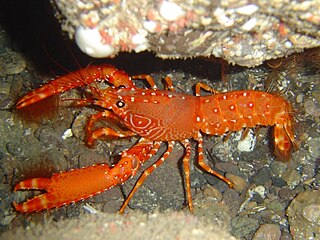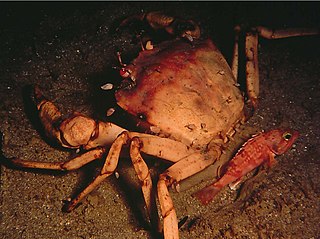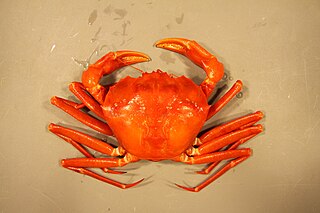
The genus Coenobita contains 17 species of terrestrial hermit crabs. Several species in this genus are kept as pets.

Reef lobsters, Enoplometopus, are a genus of small lobsters that live on reefs in the Indo-Pacific, Caribbean and warmer parts of the Atlantic Ocean.

Astacoides is a genus of freshwater crayfish endemic to Madagascar. The first specimens were brought to Europe in 1839, and seven species are now recognised, most of which are considered as threatened on the IUCN Red List. They are large and slow-growing, and are threatened by habitat loss, overexploitation by local people and by spread of introduced non-indigenous marbled crayfish. They are only found in a relatively small part of the island, mostly in undisturbed upland areas. They belong to the Gondwana-distributed family Parastacidae, but their nearest relatives live in Australasia, there being no native crayfish in mainland Africa or India.

Chaceon fenneri, commonly known as the golden crab or golden deepsea crab, is one of several species of crab harvested for food by humans. It was formerly called Geryon fenneri. Like the blue crab, its common name comes from the color of its shell; it is usually cream to tan in color. Both parts of the binomen Chaceon fenneri commemorate Fenner A. Chace Jr. It is found on the ocean floor at depths of 200 to 1,500 m (660–4,920 ft) in the tropical west Atlantic, ranging from the Gulf of Mexico to Brazil. It cannot swim. The carapace of this large crab measures up to 20 cm (7.9 in), making the entire animal similar in size to a dinner plate. Its diet includes benthic (bottom-dwelling) organisms like mollusks and worms.

Hexapodidae is a family of crabs, the only family in the superfamily Hexapodoidea. It has traditionally been treated as a subfamily of the family Goneplacidae, and was originally described as a subfamily of Pinnotheridae. Its members can be distinguished from all other true crabs by the reduction of the thorax, such that only seven sternites are exposed, and only four pairs of pereiopods are present. Not counting the enlarged pair of claws, this leaves only six walking legs, from which the type genus Hexapus, and therefore the whole family, takes its name. Some anomuran "crabs", such as porcelain crabs and king crabs also have only four visible pairs of legs. With the exception of Stevea williamsi, from Mexico, all the extant members are found either in the Indo-Pacific oceans, or around the coast of Africa.
Raymond Brendan Manning was an American carcinologist, specialising in alpha taxonomy and mantis shrimp.

Diogenes is a genus of hermit crabs.

Macrobrachium is a genus of freshwater prawns or shrimps characterised by the extreme enlargement of the second pair of pereiopods, at least in the male.
Sakalia is a genus of crabs in the family Aethridae, and was first described in 1981 by Raymond Manning and Lipke Holthuis.
Hypothalassia acerba is a large crab found in the muddy substrates of the deep seas off the southwestern Australian and New Zealand coasts. Australian distribution, which is correlated to depth and temperature, ranges from a latitude as far north as approximately 27° S on the west coast, southwards, then eastwards on the south coast to a longitude of at least 129° E. The species usually occurs in waters with temperatures of 13–19 °C (55–66 °F) and in depths ranging of 200–255 metres (656–837 ft) on the lower west coast and 90–200 m (300–660 ft) on the south coast. Body size is inversely related to depth of water. There are only two species in the genus Hypothalassia, and H. acerba is not the same champagne crab as the other Hypothalassia species, H. armata, which is found in Japanese waters.

Geryonidae is a family of crabs, including the following subfamilies and genera:

Geryon trispinosus is a species of crab that lives in deep water in the north-eastern Atlantic Ocean.
Chaceon bicolor is a species of crab.
Chaceon atopus is a species of crab.

Palaemonella is a genus of shrimp in the family Palaemonidae, containing the following species:

Chaceon is a crab genus in the family Geryonidae, and was first described in 1989 by Raymond Manning and Lipke Holthuis.

Chaceon quinquedens, commonly known as the red deep-sea crab, but sold as Atlantic deep sea red crab, or simply Atlantic red crab or red crab, is a crab that lives in the Atlantic Ocean off the East Coast of the United States and Canada, from North Carolina to Nova Scotia, and in the Gulf of Mexico.

Periclimenes, commonly known as glass shrimp or cleaner shrimp, is a commensal and often symbiotic genus of semi-transparent shrimp within the family Palaemonidae. Species of this large genus feature a wide variety of coloration and patterns, widespread distribution throughout much of the world's tropical oceans, and are often sought out for aquarium trade.

Alain is a genus of crabs belonging to the family Pinnotheridae, and was first described in 1998 by Raymond Manning. The type species of this genus was collected in Indonesian territorial waters.

Alain crosnieri is a species of crab in the family Pinnotheridae, and was first described in 1998 by Raymond Manning. This crab is found in Indonesian territorial waters.













